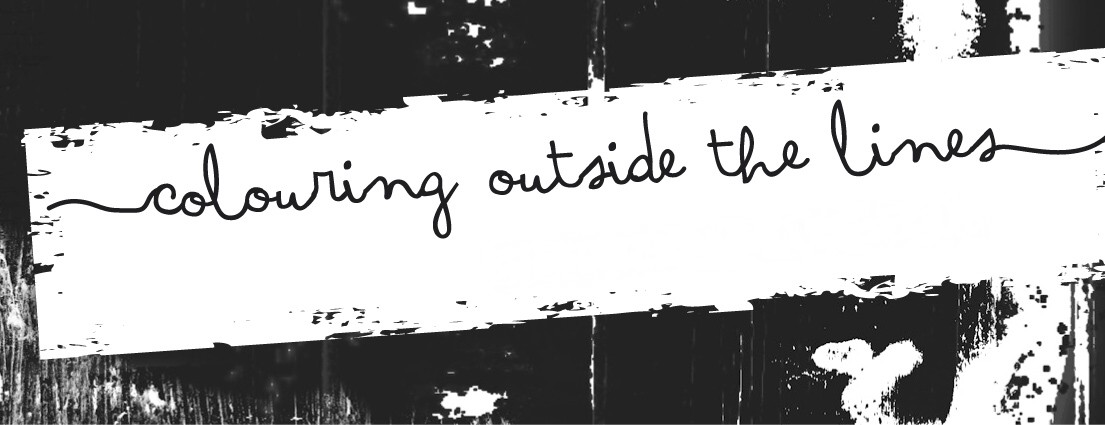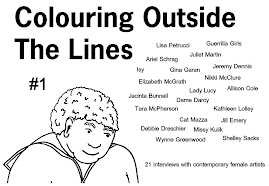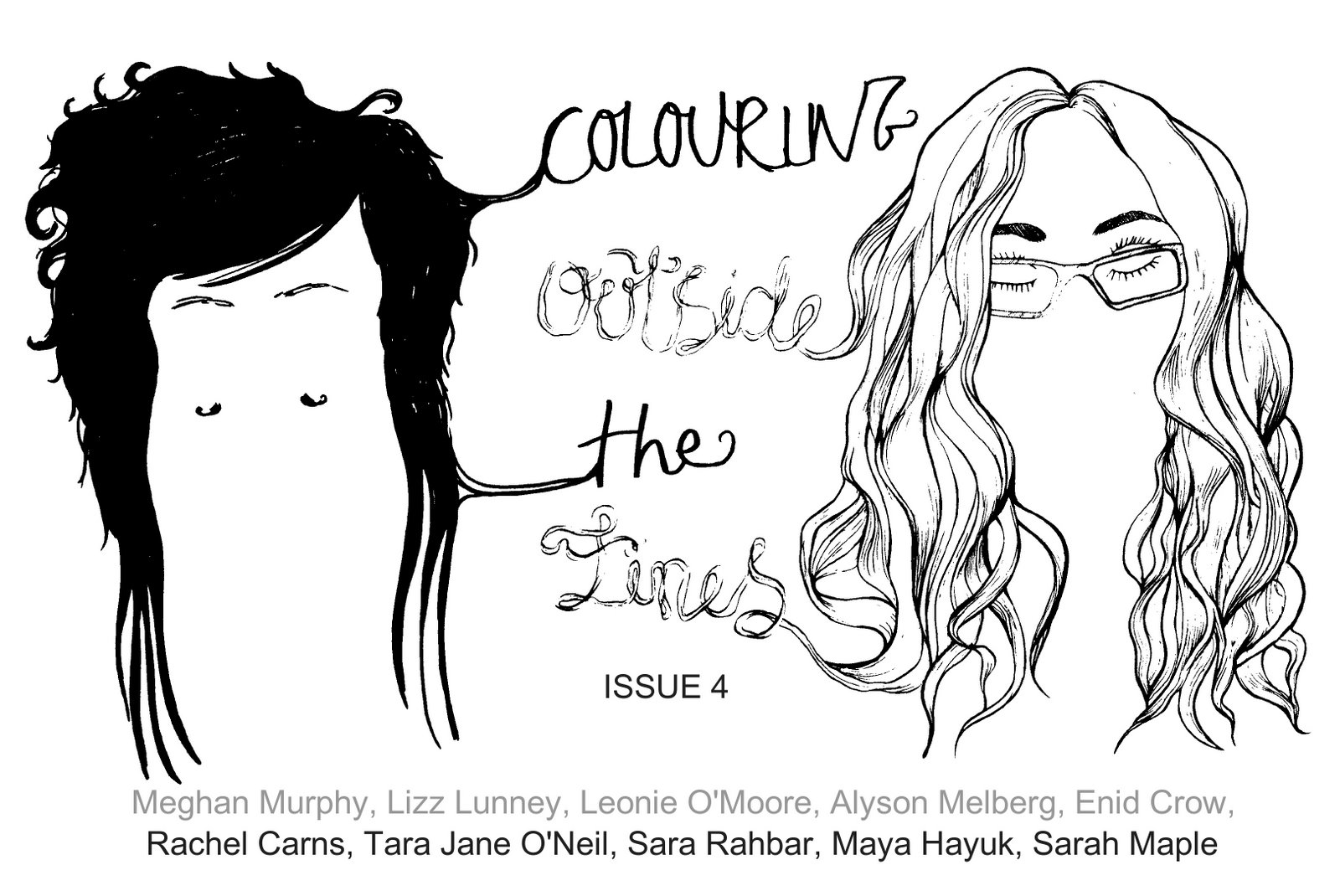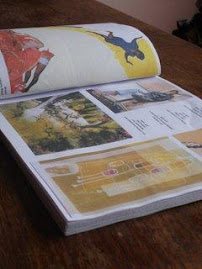



Allyson Melberg
Location: Harrisonburg, Virginia, United States
How would you describe your art?: Funny, gross, pretty, tricky, and maybe mysterious at times!
Currently working on: New drawings/paintings, small soft sculptures, new large-scale drawings, and a book with my husband Jeremy.
Day job: I am a professor of Studio Art Foundations at James Madison University. I teach 2 & 3D Design and Drawing.
3 Likes: Animals (especially cats), drawing, and sushi
3 Dislikes: Smoke, most television, and overall ignorance/intolerance
Daily Inspirations: My husband, my cat, the ocean (especially Rodanthe, Avon, and Sandbridge beaches), “Colors” book by Victoria Finlay, Haruki Murakami novels (I pretty much re-read them over and over again)
People & artists you admire: Jeremy Taylor, Louise Bourgeois, Catherine Stack, Fernando Renes, Raymond Pettibon, Kelie&Sto (Cinders), Lump Lipshitz, Barry Mcgee, Kiki Smith, Margaret Kilgallen,
Favourite album(s) to listen to when working: Anything by the Smiths, Belle and Sebastian, Best Friends Forever, Basically I like to sing along while I work. I also like to listen to movies while I work (my favorites are Pillow Talk & The Big Lebowski)
Some related websites:
www.cindersgallery.com They are my gallery representation in Brooklyn and are awesome awesome people! You can see our last show in “past shows” under September 2007
www.teamlump.org
www.allysonandjeremy.blogspot.com
Interview date: April 2008
Hi Allyson, how are you? What are you up to at the moment?
Hello, I am well thank you! I am working on these questions from our family’s home in Virginia Beach. We visit a lot. Its beautiful here, we are way out in the country very near the ocean. My Mom-in-law is an Art Teacher too and its really nice to visit her.
What is your artistic history? How did you get started, and how long have you been creating art, embracing your creativity, and working towards developing your current style and output?
I was born into a creative family. My parents met in college at the School of the Art Institute of Chicago. My Mom’s family is full of musicians and people who make things. So I never really thought that I would be doing anything else- My current style really started evolving in graduate school - Having a concentrated period of time to work and refine my ideas plus a focused dialogue with others really helped my work. This is also the time that I started collaborative relationships with my husband and Team Lump. I have had an active studio practice since I graduated from college. It is a part of life just like eating and sleeping.
Is creativity something that has been encouraged of you from an early age?
Absolutely, my parents each kept studios in our basement. My mom really involved my brother and I, getting us working with clay and drawing/painting very early. She made large ceramic vessels and would glaze them in a kiddy pool in the basement – when I was kid that seemed like magic. I really wanted to learn how to make everything! I still feel that way.
How would you describe your illustrative techniques and materials; what processes does your work go through to reach a ‘finished product‘?
I like to work out of a ground so brown/grey paper or a tinted surface are always part of beginning a piece. My technique as far as painting/drawing goes always starts out with pencil drawings. After that I work back in with walnut ink and a metal nib. If you ever feel the surface of one of my drawings you can feel that the nib has scratched all of the lines into the paper, so there isn’t much room for erasing. I like this because when I make a mistake I have to deal with it and work it in to the piece. The final step is adding egg tempera/coloring.
With soft sculpture/installation work I usually start with used/recycled fabrics and build from their individual characteristics. Most sculptures/installations are collaborative with Jeremy so we each bring our own sketches and choose materials together, then we both sew/embroider/silkscreen different parts before assembling.
I read that currently you’re working on a book project with your partner, Jeremy, about the use of non-toxic art materials. How and why is the use of non-toxic materials important to you, and your artistic practice, personally? Why do you think toxic materials aren’t questioned by many, and that alternatives aren’t sought (hence why toxic materials continue to be produced)?
Could you explain some of the books focus?
Its true! We are trying to finish it by June now that we have Archaic Mess in Richmond, (VA) putting it out. The use of ecologically sound and non-toxic art materials is important to me personally for a number of reasons. One being an educator and witnessing students who are careless with materials possibly endangering themselves or their studio mates only because they do not know better. Many instructors do not see this as a priority and set a very bad example. I do not allow the use of any toxic materials, paints, glues, etc. in my classes. Students have to be resourceful and find other solutions for making art and putting things together. In my mind if you really want to make something you will do it despite material limitations that you may find when you exclude toxic materials.
Several artists/teachers that I know have been physically affected by this but the most influential of all for me was Jeremy. He has always been an environmental/animal activist, and had been doing research on natural pigments throughout graduate school. During his assistantship in graduate school he was exposed to some toxic chemicals in the print studio and suffered irreversible lung damage which caused him to have multiple chemical sensitivities. He is a bad ass and has recovered from a lot of it, but it was a huge lesson and very scary. He was in the middle of his master’s thesis show when this happened and could not just stop making work so he used the research he was already doing on ecologically sound studio practice/natural pigments and put it to use in his work. All of his beautiful thesis paintings were made without solvents, heavy metals, or any toxic chemicals. They are biodegradable just like we are. It had a profound effect on me and was an inspiring, life-changing event. After learning about all of the things chemicals can do to your body, your environment, washing your cadmium red paint down the sink, etc. how could I possibly work with anything but natural ecologically responsible materials. Once you are cognizant of these things your conscience takes hold. It has been a really good change, I will always wish that I could take back Jeremy getting sick, but I am glad that we are making work the way we are.
I could ramble about this for hours! I guess that is why we are writing the book. We have shared a lot of this with our students at different schools, but we want the information to get out beyond that. We will be posting a PDF version of it on our blog as well.
You have worked with the band, Rainer Maria on the artwork of many of their releases. How did this collaboration come about, and is working alongside a band easier if you like, and are aware of their music (to creatively draw from, or to inspire your work, or merely to prevent your work being attached to something you aren’t comfortable with)?
My collaboration with the folks in Ranier Maria came about through our mutual friend Marshall Weber. We are all from Wisconsin! Its definitely easier to work with a band whose music you are already aware of. It felt very collaborative in the sense that we were both aware of each other’s creative work and had a very easy discussion about what they wanted and how it could relate to my art. So I felt like I was able to still make work that was natural for me and they got something really specific to their record. One interesting detail is that I didn’t hear the record for a while, I actually worked from their lyrics first so my images were based on the words not the music. By the time I worked on the music video for “Ears Ring” I knew the music well. They were really fun to work with and were extremely supportive and kind.
Your work has been published in magazines such as Bust and Venus. Is working with feminist and women-driven projects such as these important to you personally?
It was really exciting to work with these publications. It is very important to me to work with feminist projects as well as independently run projects. It was especially great to work with Venus because when I was a featured artist Sarah Silverman was on the cover! Its also great to work with women-driven projects because in some of my experiences it has really felt like a boy’s club – its nice to get outside of that.
You are a member of the art collective, Team Lump, who provide an artist-run space dedicated to exhibiting contemporary art exhibitions and projects from emerging and under-recognized artists.
How and why did you become involved with Lump?
Well, Lump Gallery is run by Bill Thelen (aka Lump Lipshitz), who is also a UNC Chapel Hill Alumni. Bill is from WI, where we had mutual friends, so when I came to graduate school at UNC we went to every Lump opening and got involved. After a year or so Jeremy and I got invited to work with Team Lump for a show called, “All Hail the New Flesh”, showcasing their newest artists. We worked with them pretty regularly after that. Lump is an amazing space, Bill works really hard to bring in challenging new work from all over.
It seems that Lump have created a great resource for artists. And in having the experimental attitude of an alternative space it appears to display diverse art in a very approachable way.
Do you think that being an artist-run space it has been set up in a way that is artist focussed, as much as art focussed?
As such is Lump supportive of all aspects of creativity, thus expanding its’ approachability on both the artist and viewers side, as a comfortable, non-elitist art space? I ask this, partly due to how alienating and ‘stiff’ some gallery and art spaces can be, and how off-putting that is.
I feel like what Bill/Lump is doing is really pure. He is supportive of the artist and the artist’s undiluted vision. Its definitely not a commercial gallery so there is so much freedom for him as a curator. He can have a show that is all wall painting or installation and he can take a lot of risks that a commercial gallery would not – which means he always shows really amazing work. I like Bill’s approach because the space definitely feels very non-elitist and welcoming while still being contemporary. Bill, who you will often meet gallery sitting on the weekends, is really approachable himself. He is this super sweet laid back guy.
Speaking of alienation in art spaces; access to viewing and thus appreciating art is often denied people (from certain economic, cultural, gendered, racial backgrounds) as much as access to and encouragement of our own creativities is, and thus the opportunities for our own artistic expression can be limited.
Have you ever encountered barriers to your creative access, or your access to art - whether as a creator or viewer?
I think spaces like Lump are really important in addressing the fact that art is not as accessible to people of all different backgrounds (economic, cultural, gendered, racial). This is why I believe that it is really important to support independent/DIY spaces. I have been extremely lucky to work with mostly independent spaces and with people who I like a lot. I also think that it is important as an artist to embrace non-capitalistic & non-gallery related ways of sharing your art with others. Personally, I have only faced one really bad situation as an artist because of my gender (and my age). I won’t name the museum but I will say it was surprising and disappointing and I had to fight to keep my show intact.
Are spaces, like that of Team Lump, something that you would have wished existed when you were first starting out in art?
Yes, of course. Lump is amazing! The fact that it is what it is and has been around for over a decade is something to be really excited about. I feel really lucky in Milwaukee, where I started out there was a really supportive and lively art community. Now that I live in a rural college town I am really missing that sense of community. We are definitely looking to move for that reason.
I am aware that your own work has appeared in exhibitions as part of Team Lump’s programme, as part of group shows. For you, what are the benefits (socially, culturally, artistically?) of being a part of group shows, over solo exhibits? Is collaboration and collectivity important to you?
In the last few years I have learned a lot about group shows since I have participated in many of them. To me they can be both good and bad. Group shows with Team Lump are really focused – we usually have a set concept so its not hard to follow through. My favourite show we did together was “Goodbye Says it All” at the Atlanta Contemporary Museum. We all stayed in an apartment together for a few days. It was so much fun and such a good show. All the group shows that I have been in with my main gallery Cinders, are really well curated so when they ask me to be in a group show I know it will be a good fit.
Group shows can be tricky though, especially if the theme is too far flung from your own content. I don’t want to be in a position where I am making work that feels unnatural to me, or contrary to what I am trying to say in my art. For example I have stopped saying yes to shows where everyone is using nasty paints in the space and spray painting all over the place because I don’t support the use of those materials- what they do to the earth and to the artists using them (even if I like their work visually). I am by no means a perfect activist, no one is! But, I do feel that I have a responsibility as an artist to say something and stick to my guns so when I get invited to a group show that is strictly based on cute animals or cool music or something I have to question it.
This is the first year we finally learned to say no to stuff that didn’t seem to fit – its really hard for me to say no to stuff because I always feel really honoured when people ask us to participate in their projects, so it has been an difficult experience, but I find that I am less stressed and making more work that is of better quality. We live in such a fast moving society, everyone is multitasking everything and most of my work just is not made that way. Realizing that and trying to get things under control has made a huge difference in my studio practice (and I actually get to sleep more!)
Solo shows can be great and allow for the further elaboration of a very specific idea/body of work. But I have often asked for collaborators in solo shows because I am not dead set on it being all MY work at MY show! I love working with my husband and when I had a residency at UVA which entailed 3 solo shows in 4 months at different university venues I made one of them into a Team Lump show and invited my students to collaborate as well. That was a great experience.
I viewed photographs from an exhibition that you and your partner were a part of, and your intricate and delicately lined work was displayed in a really fun, unusual way -- work roughly pieced and sewn together to form a giant triangle, or work pinned up under gaffer-tape signs, or pinned to a giant black thought-bubble backdrop, or on china plates, all of which presented your ideas in very approachable ways. It’s not the sort of art that I’d want to view from across an exhibition room, but would want to get up close to, bending and craning my head and neck this way and that to soak it all in, and participate in it; grinning as I went!
Your work is rarely displayed in the form of framed, polished, elitist artefacts. What are your thoughts regarding such notions of perfection and flawnessness within your own work, and the way that people can or may view your work?
Is ‘perfection’ and ‘elitism’ in art something that concerns you?
Well, I am most certainly not a robot so perfection is out! and I am very sentimental, I love mistakes and I love seeing them dealt with in resourceful and inventive ways. I like to see an artists ‘hand’ in their work and in my own work. I definitely want my viewer to feel comfortable to approach the work which, in many cases is small or had small details and needs you to come closer! I don’t want the work to be interactive (as in, I don’t want people to play with my soft sculptures as if they were toys!) but I want you to be comfortable and feel like you are participating in a dialogue. I want to share with viewers, the worst thing is going into a gallery space and feeling like you are not in the same league as the artist, that you almost couldn’t have a discussion with them even if they were right there in front of you; I welcome discussion, always. Jeremy and I also really want to create an environment for the work so that it all works together cohesively so wall painting, and hanging in a non-traditional way helps change things up. We really like to use the floor for soft sculptures so that you are not just looking at the middle of the wall for the art, its all over the place – you are in it.
How much fun is the laying out and exhibiting of your pieces (as described above) - creating an installation with your ideas?
It is a lot of fun and a lot more work than it probably seems. We make plans/sketches of possible install layouts months in advance and once we choose one stick to it pretty faithfully. We have friends who respond to a space when they get there- which can be amazing but, I guess we like to have a plan, to me that is less stressful, even if you make some adjustments while installing that change things, at least there is a sense of direction. Installing with Jeremy especially is fun. We are a good team. He always brings me tea.
The human form (in all its shapes, sizes, guises, and disguises) is something that is regularly depicted in your work, often in very truthful and realistic ways (that may be viewed as disturbing, or maybe a little grotesque in its honesty and frankness / or conversely surreal due to atypical truths). What is it about people that inspires your focus?
Being a human (and wanting to communicate things about humans to other humans) makes using the human form in my work a very easy decision. My inspiration comes from real live people, storybooks, and pictures of those who are ailing (skin disorders, tumours, etc). We have a collection of old lithographs depicting skin diseases/disorders which are beautiful and terrible. There is this sense of unapologetic grotesqueness in those types of images that is really appealing to me, the sitters look so proud. When I started making work about parabens and other endochrine disrupting chemicals in women’s body products using those images of skin diseases/tumours helped me give a form to my ideas. It also gave me a point from which to abstract and exaggerate, so that they were plausible and fantastic all at once. Disgusting and beautiful, sad and proud all at once. Using the human form makes sense to me because its what I am! And I think of it all as communicating so I figure people will understand and be able to relate to images of humans even if everything else in the image is completely surreal.
Finally, what is your favourite and most enjoyable thing about creating artwork, and being an artist that makes you continue?
For me the desire to communicate combined with curiosity about making things has kept art-making really satisfying and productive. Drawing makes me really happy. I feel like I am pissing my time away when I am away from that for too long (a few days!) It is my dream to be able to survive financially off of our art alone so that we can dedicate more of our time and get some of our bigger ‘dream’ projects made. Whether to continue or not isn’t a question, we are in this for life!















No comments:
Post a Comment